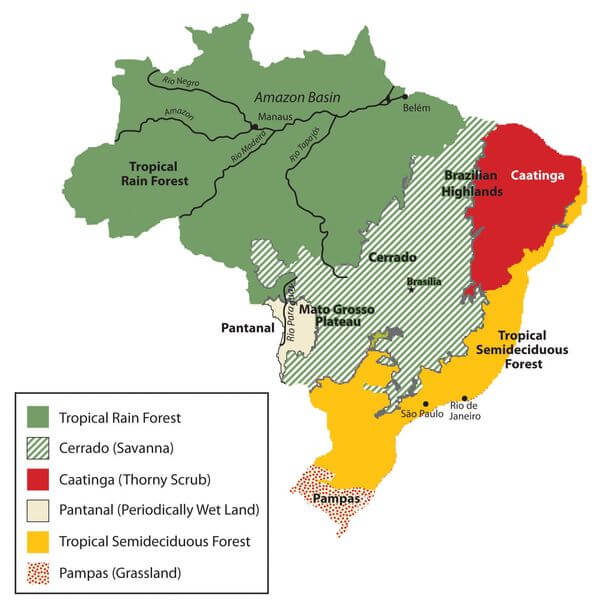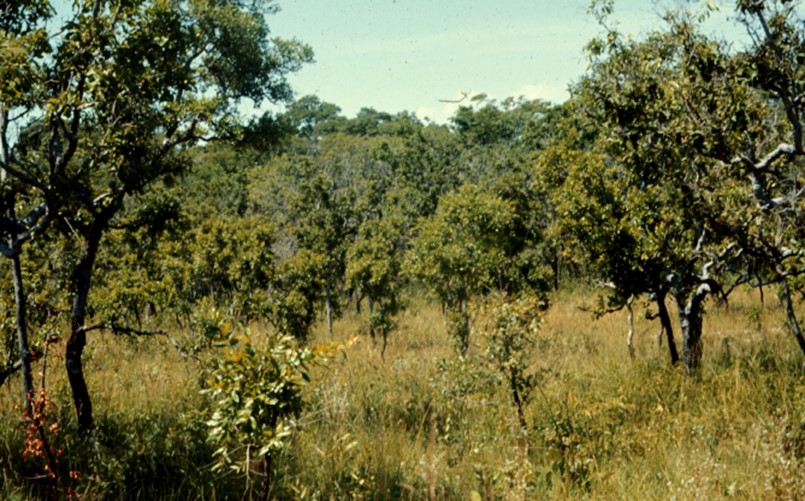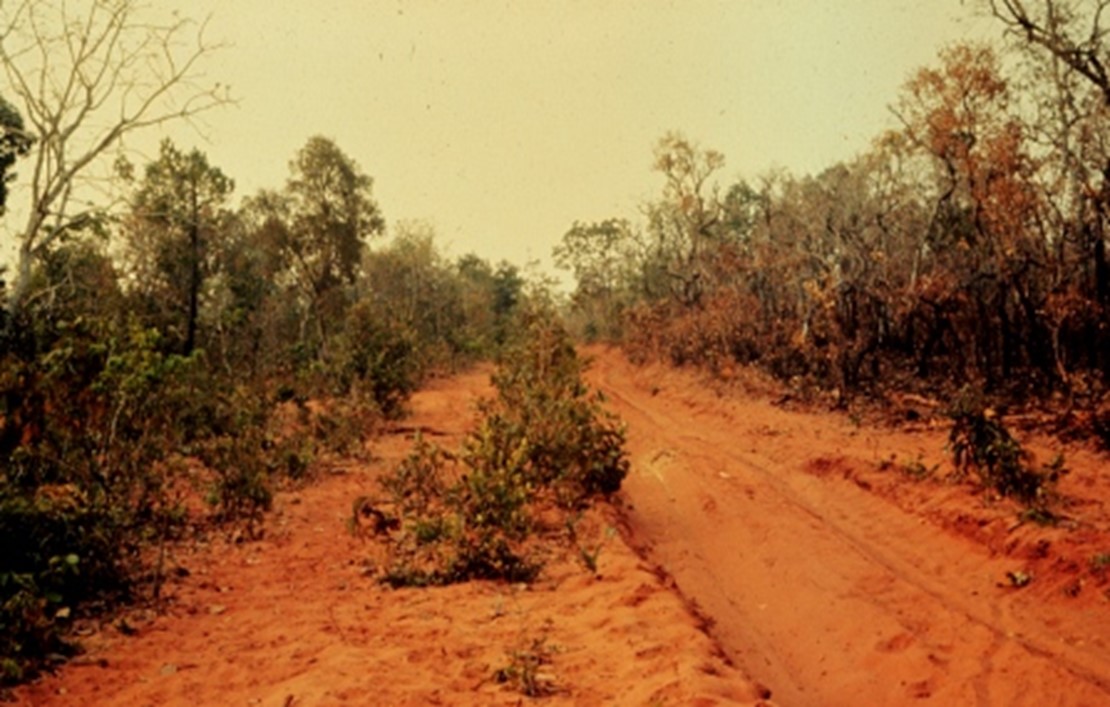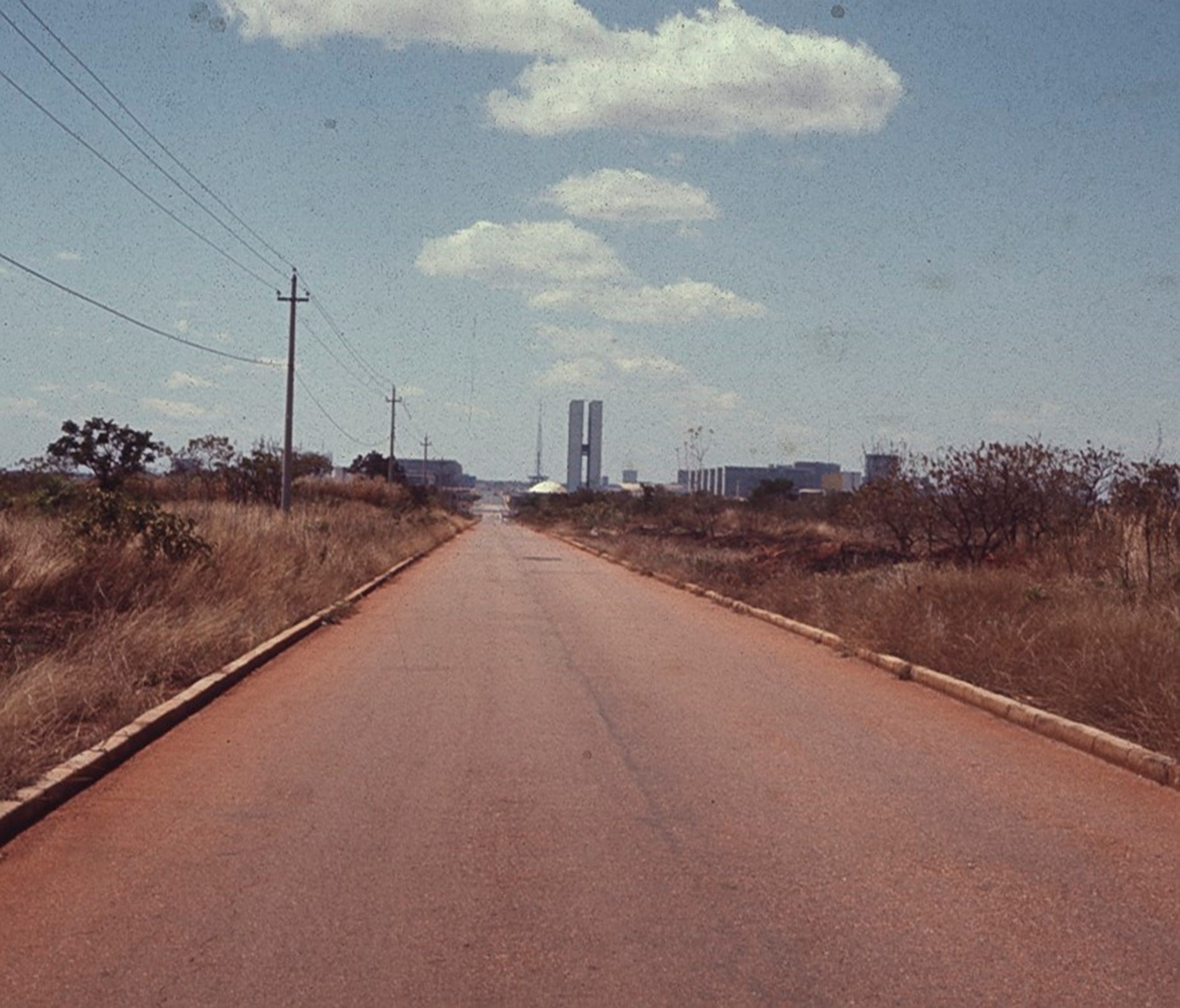80 Campo Cerrado
The Campo Cerrado is Brazil’s second largest biome (700,000 square miles) after the Tropical Rainforest. Little attention has been paid to this unique dry season forest being overshadowed by the importance of its globally significant neighboring rainforest.
 Map from LAC GEO
Map from LAC GEO
The Campo Cerrado is classified as a tropical savanna because it contains two, six-month seasons, dry and rainy. Nesting beside the Rainforest, the dry season becomes more pronounced with distance. The direct translation of Campo Cerrado is “closed field”.

 Rainy and dry season Campo Cerrado. Photos by Rick Bein 1971.
Rainy and dry season Campo Cerrado. Photos by Rick Bein 1971.
The savannas around the world each develop a character of their own having developed ecologically in isolation. The Brazilian Campo Cerrado is composed of a fire edaphic scrub forest mixed with its dominant grasses. From first glance it was labeled a forest because of the appearance of the short shrub-like trees.
Globally, in savanna lands, fire plays a significant role in its ecology, so much so, that the vegetation is dependent on periodic burning. Two Brazilian examples are mentioned here. The dominant “lixeira” (Portuguese for trash tree) seeds will not germinate until experiencing a fire. The seeds may remain on the surface, dormant, for years until fire makes its mark. The Jatoba (Hymenaea stigonocarpa} tree sheds seed pods that resist fires. Usually, fires come during the dry season when the natural vegetation is more stressed. The lixeira tree (curratela americano) trees can reach up to twenty feet.

 Fire is part of the Campo Cerrado ecology. The right side of road has been burned but the vegetation is not dead. Road served as firebreak. Note the sandy soils of the Brazilian Plateau. Photos by Rick Bein 1971,
Fire is part of the Campo Cerrado ecology. The right side of road has been burned but the vegetation is not dead. Road served as firebreak. Note the sandy soils of the Brazilian Plateau. Photos by Rick Bein 1971,
Another factor that limits the Campo Cerrado is that is lies on the ancient deep sandy soils that have developed on the Brazilian Plateau, geologically a part of the Paleozoic crust of the Gondwanaland super continent. Because of the deep nature of these soils, the tropical rainforest trees which have shallow roots, cannot survive. The deep-rooted Campo Cerrado vegetation endemic to the Brazilian Plateau still receives higher rainfall adjacent to the rainforest and the luxuriance is much greater than the rest of the Cerrado biome. This does impact the biodiversity of this part of the Campo Cerrado but most of the plant species are the same.
 When the Brazilian Government decided to construct Brasilia as its new capitol this empty Campo Cerrado land was available. I took this photo in 1971 during the construction.
When the Brazilian Government decided to construct Brasilia as its new capitol this empty Campo Cerrado land was available. I took this photo in 1971 during the construction.
Local people define the more luxuriant Campo Cerrado as “Cerradao.” They also define the driest Campo Cerrado as “Campo Sujo.” “Campo Preto” is their label for the occasional dark organic soils. There are various home remedies which are served as tea from the bark or from leaves to treat diuretic conditions and maladies of the bladder, kidneys, and coughs.
I had a firsthand experience with the Campo Cerrado in the 1960’s while working in the Brazilian Peace Corps in Mato Grosso do Sul. Again in 1971 on a research grant I drove my Volkswagen into deep sand and became entrenched. Mary and I had a somewhat terror filled moment of being stranded in the middle of the South American continent. There was no hope of anyone else coming by, so we began walking. After 10 miles we came to the village of Camapua. Relieved, we found a tow truck and driver to pull the Volkswagen out.
 This deep sandy soil was too much for this vehicle. Photo by Mary Bein 1971.
This deep sandy soil was too much for this vehicle. Photo by Mary Bein 1971.
The old farmers of the area considered the Campo Cerrado as waste land that could not be farmed. The Campo Cerrado is quite acidic with a pH of 4.9 on a scale of 14. In actuality, the Campo Cerrado can be farmed with applications of lime and fertilizers. These farmers had no access to these materials.
The potential as farmland was discovered in the 1980s when mechanized soybean farming became successful. Today vast areas of the Campo Cerrado are being farmed with inputs of chemical fertilizers. Over half the Campo Cerrado has been converted to soybeans. Some concern has arisen that this unique biome will be destroyed. The concern for the Tropical Rainforest overshadows any concerns for the Campo Cerrado.

Images from Brownfield Ag news
Soybeans in Mato Grosso Brazil. brazil agro.com.br
 A Modern central pivot irrigation makes it possible to grow soybeans in the dry season. With two harvests per year Brazil has become the leading producer of Soybeans in the world. Photo from Brownfield News.
A Modern central pivot irrigation makes it possible to grow soybeans in the dry season. With two harvests per year Brazil has become the leading producer of Soybeans in the world. Photo from Brownfield News.


